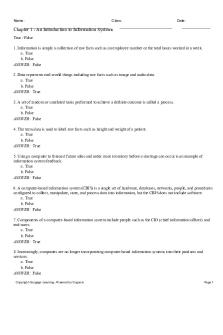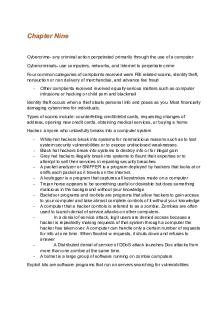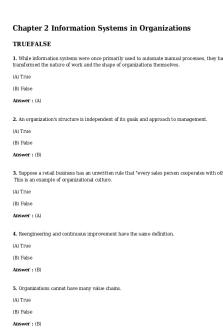Introduction to Information and Communication Technolog 1 PDF

| Title | Introduction to Information and Communication Technolog 1 |
|---|---|
| Course | Information Technology |
| Institution | Isabela State University |
| Pages | 3 |
| File Size | 40.3 KB |
| File Type | |
| Total Downloads | 540 |
| Total Views | 837 |
Summary
Introduction to Information and Communication Technology Definition of Information and Communication Technology, which refers to all communication technologies and Computer which is an advanced electronic device that is programmable. Functions of a computer which are Input, process, storage and outp...
Description
Introduction to Information and Communication Technology Definition of Information and Communication Technology, which refers to all communication technologies and Computer which is an advanced electronic device that is programmable. Functions of a computer which are Input, process, storage and output 1. It accepts and gather data (INPUT) 2. It processes data (things that we put to the computer)to become information (PROCESSING) 3. It stores data and information. (STORE) 4. It presents information. (OUTPUT) A computer understand only a binary, which is a language that represents a number of 0 and 1 Classification of a computer according to: Purpose 1. General Purpose – design for a variety of task. 2. Special Purpose – dedicated to a specific task only. Types of Processing 1. Analog – Machines that represent variables or quantities using physical analogies. ( uses analog parts) 2. Digital – Machines that specialize in counting. (designed for measuring) 3. Hybrid – Machine that incorporate measuring capabilities of the analog devices and the counting capability of the digital devices (usually composed of digital and analog processing part) Capacity 1. Micro-computer (Personal Computer) – used in homes, offices, individual and corporate uses. 2. Mini-computer ( Midrange computer) – for companies needing storage and processing requirements. 3. Mainframe computer (Large scale computer) – for medium to large business. Used by government and business companies. 4. Supercomputer – use to compute intensive tasks. Capabilities and Limitations of Computers Capabilities:
They can do repetitive and routine work Greater productivity and Less manpower Reliable and accurate Storage Capability Self-Checking Capability Self-operating
Remote Processing Multitasking
Limitations:
Cannot make decision of its own Cannot think of itself Cannot correct wrong instruction Cannot produce information of its own Vulnerable for virus attack
Uses of computer
Creates documents, brochure and pamphlets for businesses. Use it as media of learning Use it for researches Communicate with other people through chat. Use it for entertainment Use it for business online
Components of computer system Hardware – tangible part of the computer. Is the collection of all parts of a computer system. Also includes the parts inside the computer case 4 categories of computer hardware 1. Input devices – any hardware device that sends data to a computer, allowing you to interact with and control it. 2. Output devices – any peripheral that receives data from a computer, usually for display, projection or physical reproduction 3. Processing devices – ( brain of the computer) when a computer receives data from an input device, the data goes through an intermediate stage before it’s sent to an output device. A processing device is any device in a computer that interprets and manipulates incoming data during this stage. 4. Storage devices – alternatively referred to as digital storage, storage, storage media, or storage medium, a storage device is any hardware capable of holding information either temporarily or permanently. Software – is a set of programs, which is designed to perform a well-defined function. A program is a sequence of instructions written to solve a particular problem. 2 types of software 1. System software ( Operating Software ) – it is the most important software that runs on a computer. It manages the computer’s memory and processes, as well as all of its software and hardware. It also allows you to communicate with the computer without knowing how to speak the computer’s language. Without an operating system, a computer is useless.
3 most common OS Microsoft Windows, macOS and Linux (free). Mobile OS Apple IOS and Google Android 2. Application Software – or app for short, is software that performs specific tasks for an end-user. User – a person who uses computers for work or entertainment or communication or business....
Similar Free PDFs

Introduction to Communication Studies
- 220 Pages
Popular Institutions
- Tinajero National High School - Annex
- Politeknik Caltex Riau
- Yokohama City University
- SGT University
- University of Al-Qadisiyah
- Divine Word College of Vigan
- Techniek College Rotterdam
- Universidade de Santiago
- Universiti Teknologi MARA Cawangan Johor Kampus Pasir Gudang
- Poltekkes Kemenkes Yogyakarta
- Baguio City National High School
- Colegio san marcos
- preparatoria uno
- Centro de Bachillerato Tecnológico Industrial y de Servicios No. 107
- Dalian Maritime University
- Quang Trung Secondary School
- Colegio Tecnológico en Informática
- Corporación Regional de Educación Superior
- Grupo CEDVA
- Dar Al Uloom University
- Centro de Estudios Preuniversitarios de la Universidad Nacional de Ingeniería
- 上智大学
- Aakash International School, Nuna Majara
- San Felipe Neri Catholic School
- Kang Chiao International School - New Taipei City
- Misamis Occidental National High School
- Institución Educativa Escuela Normal Juan Ladrilleros
- Kolehiyo ng Pantukan
- Batanes State College
- Instituto Continental
- Sekolah Menengah Kejuruan Kesehatan Kaltara (Tarakan)
- Colegio de La Inmaculada Concepcion - Cebu












![OBrien - Introduction to Information Systems [2010]](https://pdfedu.com/img/crop/172x258/zx28ke2j06rw.jpg)

